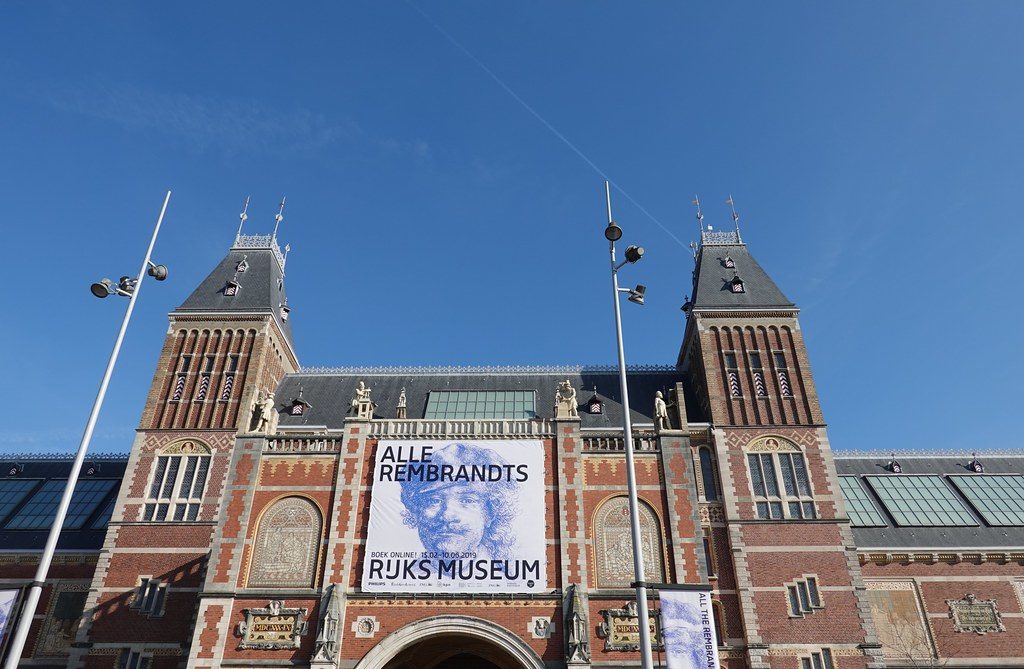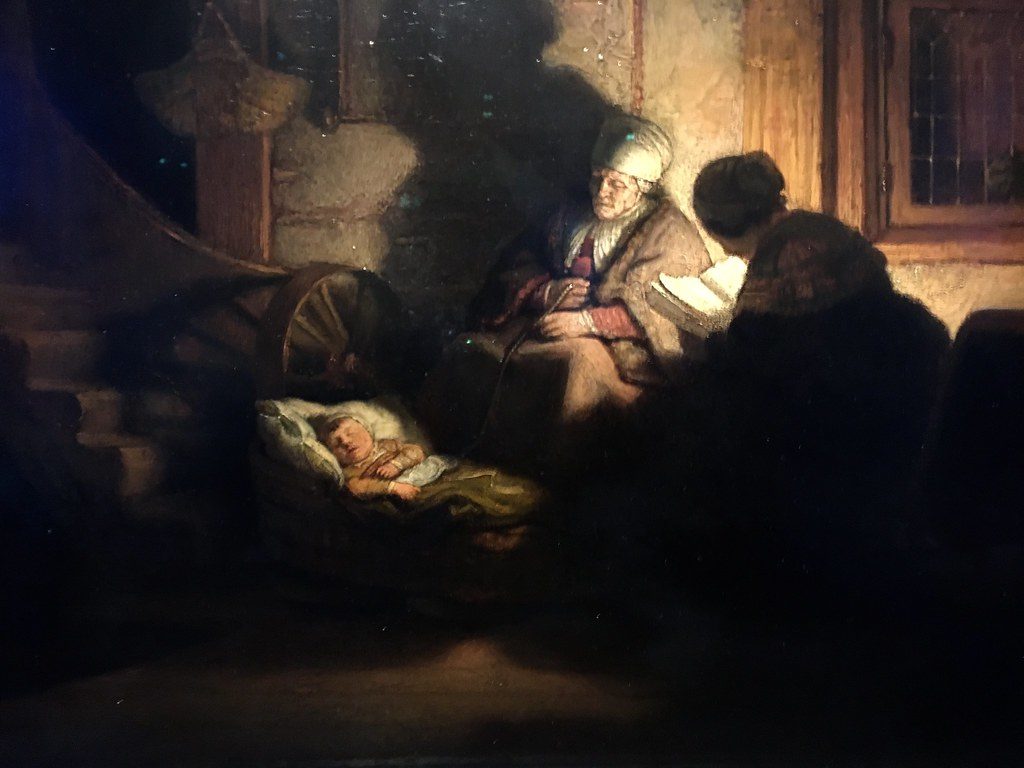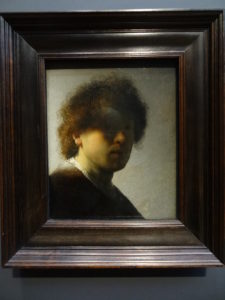
Louis A. Ruprecht Jr.
A stunning retrospective of Rembrandt’s (1606-1669) nearly fifty-year artistic career just closed on June 10, 2019, at the Rijksmuseum in Amsterdam, organized in honor of the 350th anniversary of this remarkable artist’s death on October 4, 1669.
The story starts with the artist himself because he is remembered as one of the first distinctively personal artists, one who made his own subjectivity a subject–and who, along the way, generated a body of self-portraits not to be exceeded until the late 19th century. Rembrandt was born on the 15th of July, 1606, the second youngest of ten children born to Harmen Gerritsz (a wealthy miller who died in 1630) and his wife, Neeltgen Willemsdr van Zuytbrouck (who died in 1640). Three of their children died in infancy–a harsh reality of those times, especially in a century when plague decimated the cities of Leiden and Amsterdam (Rembrandt himself lost three of his four children in infancy)–but four brothers and two sisters survived to adulthood. Rembrandt was the youngest of those who survived.
Rembrandt grew up in Leiden, the first proud Dutch city to win its freedom from the Catholic Spanish Habsburgs, and to establish a university in honor of that liberation in what had previously been a Catholic convent. The Wars of Religion are one of the most consequential contexts in which to set this artist’s illustrious career.
Rembrandt was not tagged for the industry by his parents but rather sent to the Latin School of Leiden before being “enrolled” in the Leiden University at the age of fourteen. Somehow, the young Rembrandt convinced his parents to allow him to abandon their anticipated scholarly career and to take up a three-year apprenticeship with the Leiden painter, Jacob Isaacsz van Swanenburg (d.1638) instead. After this, Rembrandt dedicated six months more to studying under the far more accomplished Pieter Lastman (d.1633), also in Leiden.
Rembrandt set up his own studio immediately thereafter, likely at the family home in Leiden; his first signed paintings are dated to 1625 and 1626. He earned notoriety quite early for his audacious experimentation with color and composition, and the deep emotional sensitivity of his early canvases devoted to historical subjects and street-life, alike. Leiden, however, was a small town from the standpoint of the arts (there was no painters’ guild), so Rembrandt took the leap and moved to establish himself in Amsterdam in 1631. Seldom were the fortunes of a city and the artistic virtues of a young painter better matched.
Rembrandt’s work is altogether a product of the Early Modern Netherlands, a funky mingling of the darkness of the north European version of the Early Renaissance, the ebullient humanism of the Renaissance at its height, coupled with an enduring Enlightenment blend of precision, naturalism, and earthy humor.

Rembrandt’s ability to play with light and shadow is unparalleled and unrivaled–how he managed to get the effects he achieved in prints and etchings is one of the many mysteries of his prodigious career. There were many images in this show that literally show up more clearly before the camera lens than they do to the naked eye. He would often experiment with the same image repeatedly (many of them biblical, as we’ll see)–doing one light and breezy, one dark to the point of obscura, and one more in the middle-range. In this, the work mirrors what he managed to do with supreme virtuosity in his most famous later oil paintings–to play with light’s absence, as well as its illumination.
Rembrandt depended on the mirror. The Rijksmusuem displayed more than 300 examples from a lifetime of his sketches and workbooks, poignant and extensive studies of his own changing face. He experimented with and on himself, attempting to work out how moods and emotions may appear to the viewer. And appear they do, throughout his career. Many see in Rembrandt’s work the dawning of a new kind of individuality and interiority, especially the earthy humor to which I have already alluded. There are some striking sketches (both early and late) of blurry lovers coupling in the woods, in haystacks, in their own beds. He also demonstrates a fascination with images of pissing out of doors–the men depicted fully frontal and in mid-stream, the women demurely kneeling behind a bush or in front of a tree. The theory of bodily humors passed out of fashion very slowly in Europe, even as the interest in bodily fluids flowed into other aesthetic and scientific channels.
Rembrandt’s career was really launched when he earned fame as a much-sought-after portrait painter in the mid-1630s. He painted elegance, excess, wealth and pride with uncommon frankness. The new power-base of commercial guilds were regular and enthusiastic patrons. And that, it seems to me, is what makes Rembrandt such a singular product of his place and time.
Amsterdam: the birthplace of global trade and global banking, that powerful combination which enabled the Dutch Republic to do what the Venetians and Portuguese had failed to do. (Of course, the British would perfect what the Dutch invented, and New Amsterdam would eventually become New York). What we are witnessing here is the first dramatic pass at modern globalization under the aegis of finance capital, and the effects are dazzling. The buzz of economic activity, from Indonesia to the West Indies, fueled a new interest in spices, ethnic foods, ethnic costumes, the vast panoply of human diversity, religious diversity included (the Rijksmuseum also boasts a supremely beautiful collection of Indian, Chinese and Japanese art notable not just for its imperial legacy, but for each piece’s being a masterpiece). Rembrandt’s still lifes put exotic new items on his tables; his sketches of street-life are notably graced with a remarkable range of eastern costumes. He was also keenly aware of the displacements created by this new boom-town economy; his studies attend closely to poverty and displacement, featuring beggars and the homeless. He was painting the new world he was watching emerge, changing and transforming all that had come before. In revisiting the features of his own changing face over five decades, he was doing in miniature what he did on a much larger scale for the Netherlands.
There were new religious sensibilities afoot as well, of course. Amsterdam was now in a position to rival the Vatican for its wealth, its art collections and its theology. Rembrandt’s father was of the Reformed Church, the national church of the Dutch Republic, but his mother had been raised Roman Catholic. Rembrandt’s work splits the difference, it seems to me: no iconoclastic Reformer, he was immersed in and enamored of images; no immaterial spiritualist, he was fascinated with the meatiness of actual bodily forms in all their variety. What we see in Rembrandt’s artistic vision is not so much a new spirituality as new materialism, a new interest in materiality. The close attention to meat, to flesh, to finery, to the trappings of trade and usury… in all of this, we are witnessing a tremendous turning toward, not away, from the physical world. Rembrandt does not paint renunciants, with the intriguing exception of Saint Jerome, who was a perennial object of interest for the painter throughout his career (quiet deference, perhaps, to the scholarly life he abandoned in order to paint).
Rembrandt’s biblical studies were organized in three parts in this exhibition: Old Testament, New Testament, and Early Christian. What is striking throughout these galleries, in sketches and etchings as well as in oil, is Rembrandt’s manner of envisioning the scenes in real human settings: he bears witness to the intensity and pervasiveness of human interactions (only his portraits ever depict a single person, alone, from the time of his arrival in Amsterdam), the omnipresence of animals in human society, and the vast range of his own emotional palette, the sheer un-idealized humanity that so clearly thrilled him.
Rembrandt’s work demonstrates a deep appreciation for the Hebrew Bible as well as, so it would appear, the contemporary Jews of Amsterdam. He rendered print portraits of Dr. Ephraim Hezekiah Bueno, a Jewish neighbor who also held a stake in the publishing house of Menasseh ben Israel, for which Rembrandt did illustrations. He surely would have understood their strong hand in the new book and banking economy (something equally notable in Venice at the time). Rembrandt’s repeated versions of the Akedah, Abraham’s abortive sacrifice of his son, Isaac, are all done with powerful emotion and strong strokes. His fascination with the figure of Joseph–the audacity of his dreams, his beauty, his incorrigible successes–was lifelong. Perhaps there was a sting of jealous amazement at work here, as Rembrandt notoriously bankrupted in the 1650s and thus worked in grinding poverty for his final decade. The winning and losing of fortune: this is the topsy-turvy, boom-and-bust world of global capital.
Rembrandt’s treatment of New Testament subjects seems somewhat tame, by comparison. There is abundant interest, especially in the sketches, in Christ’s infancy, the family’s flight to Egypt, and an early childhood culminating in his debate with rabbis in the Jerusalem Temple at the ripe age of twelve (it takes a prodigy to know a prodigy). The real accumulation in these studies, both the sketches and the more elaborated canvases, focus on the pains and passions of the adult Christ: the cleansing of the Temple, the anguished prayer in Gethsemane, the presentation before Pilate, the march to the Cross. Even more distinctive are Rembrandt’s treatments of the cruel materiality of death: the descent of Christ’s corpse from the Cross together with its actual entombment, and then, after the rising, his visits to Mary and the other disciples. This room concludes with the Dormitian of his Mother, one of the few serene scenes he chose to depict.
The post-biblical religious scenes are somewhat random: all of the many versions of Saint Jerome, a Saint Francis, and an especially moving portrait of his youngest son, Titus, dressed as a Franciscan monk. The Franciscan order, of course, privileged vows of poverty and obedience, and this would have spoken profoundly to Rembrandt when he made the study in 1660. For Rembrandt was much like the Dutch tulips: he skyrocketed to fame and early fortune in the 1630s, then fell from favor and went bust in the 1650s (see Alizeh Ahmad’s recent piece on the tulip phenomenon in the Netherlands). He was forced to sell most of his work to clear his debts, which is one more reason why there is so much of his work in London, Paris, Berlin, Munich, New York, and elsewhere. It was his son, Titus, in any case, who created a ghost company and then hired his father as its sole employee–to keep his possessions from his creditors and to enable him to continue to work, albeit on a lesser scale. That is how Rembrandt managed to paint nearly to the end, with flashes of unprecedented brilliance even by his exacting standards.
But the end was punctuated by worse humors, the tragedy of wave after wave of loss. Rembrandt lost his beloved wife, Saskia, in 1642, when she was just shy of thirty years old; her face and features would recur poignantly throughout much of Rembrandt’s subsequent career. His later mistress of many years, Hendrickje Stoffels, died in 1663, leaving their eight-year-old child, Cornelia, to her own financial woes. His resourceful only surviving son by Saskia, Titus, died in 1668, just one year before his father did, and at just 27 years of age. The world was changing, and another new world would require new arts and artists, his own students among them.
And yet. If tulips no longer command the fortunes they once did, the Flower Market in Amsterdam still presents itself to the fortunate visitor with riotous color and delightful energy. If he died a relative pauper, Rembrandt stands now among the most prized of Early Modern artists and certainly the most prized of his native Holland. While the Rijksmuseum was notoriously short on Rembrandts in its early years, it undertook a massive acquisition program throughout the 20th century, for which we may be most grateful. That curatorial vision created the conditions which made this show possible.
It offers a glimpse, not just into this singular artist’s workshop, but into the positions and the conditions that serve to make all of us modern.

The first self-portrait of Rembrandt rendered in oil is dated to 1627 or 1628; he would have been 21 years old when he did it. There are already certain features that will become iconic: the unruly mop of wiry hair, the blunt, flattened nose, the sensual lips. But Rembrandt has elected to depict himself backlit so that his eyes are completely invisible, lost in deep and ominous shadow. The artistic canons of the day demanded that the artist paint the “passions of the soul,” and those passions were believed to be most visible through the eyes, which were thought of as “windows on the soul.”
In this painting, Rembrandt hides his passions by closing the windows. This is surely the most uncanny, the most religiously ambivalent, portrait of its day. For all of our admitted fleshiness and visual transparency, we all have hidden inner depths invisible to the eye and unavailable to the artist’s brush or knife. Rembrandt’s spiritual audacity in daring to paint that new, modern insight, is arguably the most amazing thing about him, as was displayed so beautifully in this retrospective. It opens a window, not onto an individual soul, but onto our world, just then in-the-making.
Louis A. Ruprecht Jr. is the William M. Suttles Professor of Religious Studies in the Department of Anthropology at Georgia State University, where he also serves as the University Director of the Center for Hellenic Studies.
